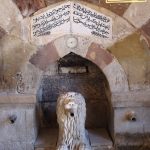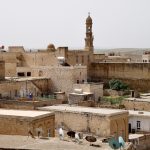The lost city Population: 3,000 (Yeni Hasankeyf)
Other names: Hisn al-Kifa, Heskif (Kurdish)
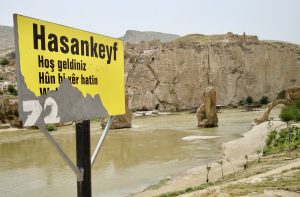 For some years Hasankeyf was a cause célèbre for environmentalists horrified at the idea that the planned Ilısu Dam would flood the ruins of a glorious ancient settlement on the banks of the Tigris (Dicle) river. Such was the international outcry that the British government was forced to backtrack on plans to support the dam. By pulling the financial plug they left the project temporarily high and dry. Unfortunately that was not the end of the story and work ploughed ahead both on the dam and on Yeni Hasankeyf (New Hasankeyf), the new settlement to which the much reduced local population would be moved.
For some years Hasankeyf was a cause célèbre for environmentalists horrified at the idea that the planned Ilısu Dam would flood the ruins of a glorious ancient settlement on the banks of the Tigris (Dicle) river. Such was the international outcry that the British government was forced to backtrack on plans to support the dam. By pulling the financial plug they left the project temporarily high and dry. Unfortunately that was not the end of the story and work ploughed ahead both on the dam and on Yeni Hasankeyf (New Hasankeyf), the new settlement to which the much reduced local population would be moved.
Then in 2019 the worst came to pass. The dam opened and by July 2020 most of old Hasankeyf had vanished beneath the ensuing reservoir, such of its residents as wanted to stay being moved into nearby Yeni Hasankeyf. What appears here is therefore a historical description of what has been lost pending the day that I can face returning to see what survives of a place I remember as one of the loveliest in south-eastern Turkey.
Linguistically Hasankeyf is interesting since many of the population are trilingual, speaking Arabic or Kurdish as their primary language with the other as a second language and Turkish as a third.
Backstory
Just as in Cappadocia, some of the cave dwellings at Hasankeyf date back to the centuries before written records. However, the expanding settlement didn’t really come into its own until the 12th and 13th centuries when it was governed by the Artukids, an offshoot of the Selcuks who also held sway in Mardin.
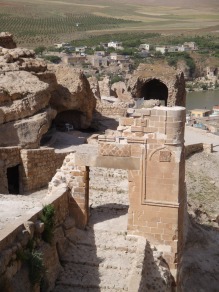 Eventually their place was taken by the Ayyubids who were, in turn, replaced by the Akkoyunlu (White Sheep) dynasty. It was their king Uzun Hasan (Tall Hasan) who built the imposing palace on the summit of the rock, but tempting as it is to imagine that he also bestowed his name on the settlement, Hasankeyf actually appears to be a corruption of the Arabic Hisn al-Kifa, meaning ‘fortress of the rock’.
Eventually their place was taken by the Ayyubids who were, in turn, replaced by the Akkoyunlu (White Sheep) dynasty. It was their king Uzun Hasan (Tall Hasan) who built the imposing palace on the summit of the rock, but tempting as it is to imagine that he also bestowed his name on the settlement, Hasankeyf actually appears to be a corruption of the Arabic Hisn al-Kifa, meaning ‘fortress of the rock’.
In 1260 the Mongols roared into town and undermined the White Sheep rulers who nevertheless managed to cling onto power until 1416 by which time the Ottomans also had Hasankeyf in their sights. However, once they had eliminated the threat to their borders from Safavid Iran the Ottomans lost interest again and left the town to fall into the slumber from which it was eventually awoken by the dam furore.
Around town
Of all the sites in south-eastern Turkey Hasankeyf’’s was arguably the most spectacular. As you approach across the flat plain from Batman, a dramatic sweep of curved rock suddenly jutted up above the cool blue waters of the Tigris, while the abandoned struts of the old Artukid bridge (restored even while work on the dam was ongoing) hinted at the treasures to come.
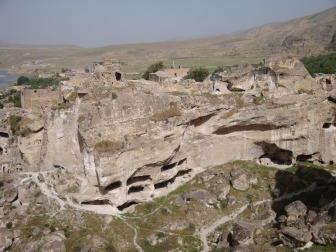 The approach from Midyat was less dramatic since it sneaked you in at the rear where the souvenir stalls were a tad offputting. However, you only had to walk past them to find yourself in an echoing gorge riddled with old cave homes. To the right the ruins of the old town straggling up the cliff-face held out an unignorable invitation to commence climbing.
The approach from Midyat was less dramatic since it sneaked you in at the rear where the souvenir stalls were a tad offputting. However, you only had to walk past them to find yourself in an echoing gorge riddled with old cave homes. To the right the ruins of the old town straggling up the cliff-face held out an unignorable invitation to commence climbing.
A cobbled path zig-zaged up to the top of the gorge, passing through a graceful monumental gateway dating back to the 14th century. Eventually you arrived at the remains of the Small Palace built by Uzun Hasan. The path continued to wind ever upwards until it deposited you near the ruins of the Big Palace and the Ulu Cami. The mosque date dback to the 12th century and had survived with its dome intact into the 21st century when misguided protestors against the dam clambered on top of it, causing it to collapse.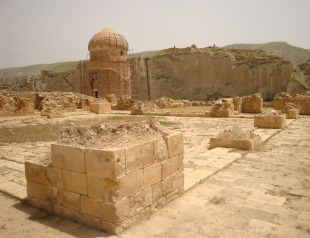
Up near the mosque stood the remains of stone-fronted cave houses very like those in Cappadocia. These continued in occupation into the 1970s when the residents opted to be rehoused back at ground level.
The main attractions at Hasankeyf were grouped together around the gorge, but there were also a few outlying sites as well. These included a cute domed tomb covered in green and blue tiles that housed the remains of Uzun Hasan’s son Zeynel Bey and dating back to c. 1480. This has now been moved to a new Hasankeyf Archaeological Park along with several others of the historic structures.
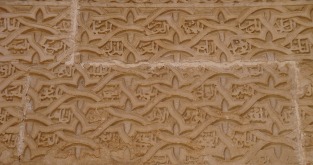 Also worth a look was the graceful stone minaret of the El Rizk mosque, which rose up near the bridge in the heart of the modern village. With teardrop-shaped panels of calligraphy dripping down its façade, it looked very like the minarets in Mardin.
Also worth a look was the graceful stone minaret of the El Rizk mosque, which rose up near the bridge in the heart of the modern village. With teardrop-shaped panels of calligraphy dripping down its façade, it looked very like the minarets in Mardin.
The mosque itself was less interesting, the original having long ago slipped into the river. However, the elaborate carved panel over the entrance was said to represent the 99 names of Allah.
Frequently overlooked by visitors since they were isolated in a part of the village apart from the main path were the remains of the lovely 14th-century Koç and Sultan Süleyman Camis.
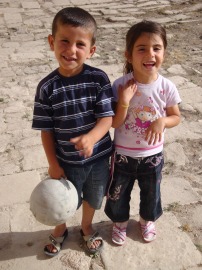 What will the future hold for these Hasankeyf children (2011)?
What will the future hold for these Hasankeyf children (2011)?
Sleeping
There are plenty of business-class hotels in Batman or you can stay in much more inviting Midyat.
Transport
Regular dolmuşes from Batman to Midyat pass through Hasankeyf. You can also organise a taxi excursion from Mardin – it takes two hours in each direction.
Day trip destinations
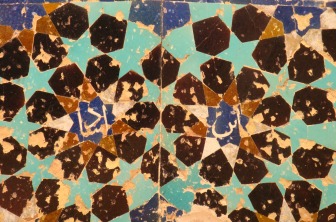 Tiles on Zeynel Bey Türbesi
Tiles on Zeynel Bey Türbesi
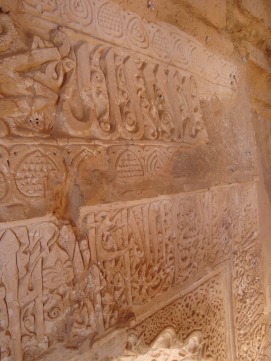 Elaborate carvings in Sultan Süleyman Cami
Elaborate carvings in Sultan Süleyman Cami

